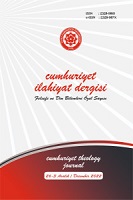Mevlânâ’da Kötülük Problemi ve Zıtlıklar Teodisesi
The Problem of Evil in Mawlânâ and Theodicy of Contrasts
Author(s): Fatma YüceSubject(s): Islam studies, Middle-East Philosophy, Philosophy of Religion, Sociology of Religion, History of Religion
Published by: Cumhuriyet Üniversitesi İlahyat Fakültesi
Keywords: Philosophy of Religion; The Problem of Evil; Theodicy; Mawlânâ; Contrast;
Summary/Abstract: The problem of evil and theodicy is one of the most important subjects in the field of Philosophy of Religion. The problem of evil is basically stated as the problem of incompatibility of the existence of God with evil. While the problem of evil is used to justify atheistic claims, theodicy has been developed to strengthen theistic claims against the problem of evil. Mawlānā, D̲jalāl al ̲ - Dīn Rūmī (1207-1273), who is the important sufi thinker of Turkish-Islamic culture, is generally known for his mystical and literary works. Although Mawlânâ's philosophical views have not been studied sufficiently, it is seen that he presents his important ideas in the philosophical field, especially in the philosophy of religion, in a non-systematic and hidden way in his works. In this study, the problem of evil has been studied in the case of Mawlânâ, within the scope of the evil’s types and the problem of evil’s types in the literature. In addition, it has been examined whether Mawlânâ discussed the evil as a philosophical problem and contributed to the solution of the problem of evil. There are three types of evil in the literature of Philosophy of Religion: Natural Evil, Metaphysical Evil and Moral Evil. Although Mawlānā does not clearly define these types of evil, his perception of evil is similar to the three types of evil in the literature. However, Mawlānā rejects natural evil and in some measure accepts metaphysical evil. What Mawlānā understands from evil is exactly moral evil. According to Mawlānā the moral evil results from alienation from God, giving a lot of importance to material things and neglecting spirituality. Thus, he adds a spiritual and divine dimension to the concept of moral evil which takes part in the literature. As it is seen, Mawlānā does not systematically discuss the types and definitions of evil. By the same token, he does not discuss the problem of evil and does not offer solutions to the problem of evil. Themes related to the problem of evil are found in the examples and the subtext of his couplets. Three basic problems of evil are mentioned in modern debates: The Logical Problem of Evil, The Evidential Problem of Evil and The Existential Problem of Evil. When the problem of evil is evaluated in terms of Mawlānā's views, the contradiction between God and evil in the logical version of evil is cancelled and the God-evil dilemma (There is either God or evil) becomes a false dilemma by demonstrating a third possibility which both God and evil exist. On the other hand, Mawlānā's views which emphasize the goodness and the order of the world have the potential to respond to the evidential problem of evil. Mawlānā has taken a quite different approach to the themes of death and freedom whose contradiction with God and his power is used to justify the existential problem of evil. According to Mawlānā, the human freedom does not confine the power of God and death which is a new birth and the beginning of a new life, is not evil rather it is good. All in all, there is not the problem of evil, but there is theodicy in the views of Mawlānā. In this study, the theodicy used by Mawlânâ, which is related to contrasts, has been called the theodicy of contrasts and has been explained and systematized. There are seven arguments in the theodicy of contrasts: Argument 1: The evil is the part of the natural equilibrium, Argument 2: Since good and evil exist together, the point of view comes into the prominence, Argument 3: The evil is necessary for the understanding of good, Argument 4: There is the evil for the greater good, Argument 5: There are situations which good is in the evil and evil is in the good, Argument 6: The evil is actually good and Argument 7: It is possible for the good-bad duo to merge in the good: Unity. Mawlânâ's understanding of God has been labeled as theist, pantheist and panentheist from time to time. It is known that Mawlânâ defends God as an omnipotent, omniscient and all good within the framework of the understanding of tawhid. At the same time, it is seen that Mawlânâ claims that good and evil merge at the final point. In previous studies on Mawlânâ, it was often emphasized that his conception of God is both immanent and transcendent. There is a theistic tendency in Mawlânâ's attempt to preserve the attributes of God, and a pantheistic tendency in the idea of merging the good-bad duo in the good. It could be argued that Mawlânâ is more likely to be a theist or panentheist than a pantheist due to his emphasis on both a transcendent and an immanent creator. In addition, these two probabilities make it possible to discuss the problem of evil in Mawlânâ. It is known that theodicy related to theme of contrast was developed before Mawlânâ. As a result, although it cannot be said that Mevlânâ made an original contribution to the problem of evil with his theodicy of contrasts in terms of content, it can be claimed that his treatment of the problem is original considering his style and his appeal to metaphors.
Journal: Cumhuriyet İlahiyat Dergisi
- Issue Year: 26/2022
- Issue No: 3
- Page Range: 1003-1019
- Page Count: 17
- Language: Turkish

